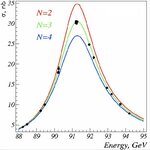Physics

Simulation, noun:1. Imitation or enactment2. The act or process of pretending; feigning.3. An assumption or imitation of a particular appearance or form; counterfeit; sham.
Well, high-energy physics is all about simulations.
We have a theoretical model that predicts the outcome of the very energetic particle collisions we create in the core of our giant detectors, but we only have approximate descriptions of the inputs to the theoretical model, so we need simulations.
E.g., the parton distribution functions f(x,Q^2) of quarks and gluons inside the proton, which determine how…

Neutrinos, the most mysterious and fascinating of all elementary particles, continue to puzzle physicists. 20 years after the experimental verification of a long-debated effect whereby the three neutrino species can "oscillate", changing their nature by turning one into the other as they propagate in vacuum and in matter, the jury is still out to decide what really is the matter with them. And a new result by the MiniBoone collaboration is stirring waters once more.Neutrinos are ubiquitous. We are constantly traversed by millions of them, as they come from three independent sources in large…

Living in Padova has its merits. I moved here since January 1st and am enjoying every bit of it. I used to live in Venice, my home town, and commute with Padova during weekdays, but a number of factors led me to decide on this move (not last the fact that I could afford to buy a spacious place close to my office in Padova, while in Venice I was confined to a rented apartment).Besides the nice fact that my alarm clock has been disposed of, and that my commute time has been cut by a factor of seven, Padova offers more to somebody like me than Venice. Venice is an astoundingly beautiful place,…

A paper by B. Fornal and B. Grinstein published last week in Physical Review Letters is drawing a lot of interest to one of the most well-known pieces of subnuclear physics since the days of Enrico Fermi: beta decay.The mechanism by means of which a neutron transmutes into a proton has been studied for decades before the neutron was officially discovered (by Chadwick, in 1932). That is because beta decay is at the heart of radioactive processes: nuclei of elements rich with neutrons can turn into others by turning one of their neutrons into a proton, with the emission of an electron and an…
Like sex, Stephen Hawking was and is mainly a cheap way to obtain publicity. They still publish posthumously now to keep it going. The media feast on the occasion of his parting was not enough, sadly also here at Science2.0 by the usual suspects. I refused participation, because there is just nothing good to say, but the “he just dead, you can’t say that”-period has passed now, too. Let’s be scientific: Hawking’s main contribution was sitting in a wheelchair! The only science worth mentioning he did is applying Unruh temperature, the black body radiation experienced due to quantum effects…

Frank D. Smith (Tony Smith for his friends) has been following this blog since the beginning. He is an independent researcher who is very interested in phenomena connected with the top quark and the Higgs boson. He has a theory of his own and he has been trying to check whether LHC data is compatible or not with it. His ideas are reported here as a guest post, as a tribute to his faithfulness to this site. Of course the views expressed below are his own, as I retain a healthy dose of scepticism to any bit of new physics apparent in today's data... Also, I will comment in the thread below to…
These days the use of machine learning is exploding, as problems which can be solved more effectively with it are ubiquitous, and the construction of deep neural networks or similar advanced tools is at reach of sixth graders. So it is not surprising to see theoretical physicists joining the fun. If you think that the work of a particle theorist is too abstract to benefit from ML applications, you better think again. Think again - that's exactly the aim of the workshop I have attended the past few days in Durham. It was probably meant to be titled "Machine Learning for…

Relativity is a form of symmetry and for that reason already of fundamental importance for science. Symmetry means: You can change something in some quite fundamental way, for example rotate the whole circle, and yet, the result is in some other important way the same, the circle is in all ways we can notice as it was before the rotation. The law of the conservation of energy is such symmetry: We transform local chemical energy into non-local kinetic energy and back, yet its mass stays the exact same throughout. We usually call ‘Relativity’ a symmetry that involves transforming the observer/…

Yesterday's seminar at CERN by Giuseppe Ruggiero unveiled the preliminary results of a search for the rare decay of charged kaon into a pion and a neutrino-antineutrino pair, performed by the CERN NA62 experiment. The result in truth had been already shown a couple of weeks before at the Moriond conference, so it's no news - or if you prefer, it's two nu's - as indeed (spoiler alert) one such event was observed, with two neutrinos inferred from it.
Observing decays of the kaon to pion plus neutrino pair is not an easy feat: if the Standard Model is correct (and we have no reason whatsoever to…

Energy is not a substance, not something in the sense of “some thing”. Energy often appears to be a substance that flows, for example if charging a battery or an electrical capacitor. When charging, also electrons flow into these devices, but as many electrons flow out of the device. Nevertheless, there is something flowing into the device, namely energy. Moreover, the charged electrical capacitor is a tiny little bit more massive, more heavy than before, because an amount of energy E has always the mass m given by the famous equation E = m c2. Therefore, when charging a battery for example,…